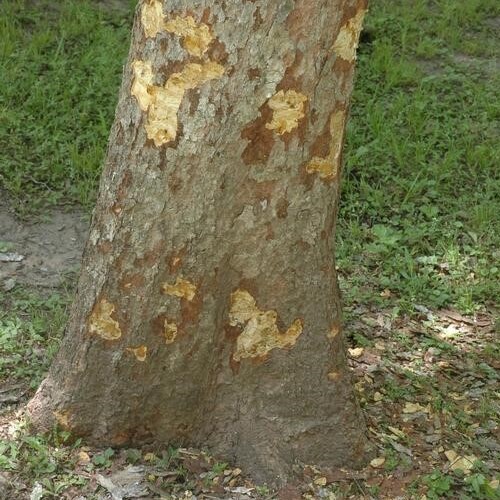A native of Mexico, the soapberry borer, Agrilus prionurus, Coleoptera: Buprestidae, was first reported in Travis County in 2003. Since then, it has been detected in 49 additional counties including near or within the cities of Austin, College Station, Corpus Christi, Dallas, Fort Worth, Houston, and Waco.

Western soapberry, Sapindus saponaria, var. drummondii, is a medium-sized, drought-hardy tree with leaves and fruit that resemble those of the invasive Chinaberry tree. But the leaves are not double compound and the leaflets do not have serrated (toothed) margins.
Soapberry trees infested by the soapberry borer can be easily recognized by the exposed sapwood seen when birds and squirrels chip off the bark to feed on the larvae, leaving bark chips to accumulate at the base of the tree. A heavily infested tree will be completely girdled by white larvae feeding beneath the bark.
Infested trees die back from the top and often produce abundant sprouts along the trunk. Trees may take up to three years to die, following the initial beetle attack.
Life cycle
The adult soapberry borer beetle is about half an inch long, shiny black, and distinctively marked with four small white spots on the wing covers.
The white larvae are flat-headed wood borers that may grow an inch or more in length as they mature. After feeding beneath the bark, the larvae bore into the wood to complete development and to pupate.
Adults leave a D-shaped exit hole in the bark as it emerges. The insect appears to have no more than one generation per year, with adult beetles emerging from May through August.

Control
Western soapberry exhibit little resistance to invasive soapberry borers. However, to protect high-value soapberries in your yard, conventional borer preventative treatments may be applied prior to insect attack. – Products that contain imidacloprid, like Bayer Advanced Tree and Shrub Insect Control.
A systemic insecticide, emamectin benzoate, sold by Syngenta Corporation under the trade name Tree-äge, is also available and may provide prolonged protection up to two years with a single trunk injection.
Unlike imidacloprid, emamectin benzoate is a restricted use insecticide. It can only be purchased and applied by certified pesticide applicators. Systemic insecticides are most effective when applied to soapberry trees prior to beetle infestation, although chemical treatments may save trees in early stages of insect attack if the tree still has sufficient green foliage and bark loss is minimal.
No other tree species seem attacked by this insect so treatment should be limited to soapberry trees.